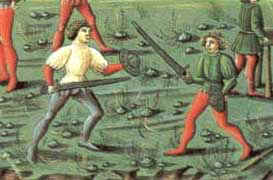 The Sword & Buckler Tradition -
Part 1 The Sword & Buckler Tradition -
Part 1
By J. Clements
Along with the longsword as
a foundational weapon of training, the ARMA has always emphasized
the sword and buckler as a vital tool of study. We now
present here one of the most comprehensive looks at this system
ever offered. The conclusions that can be drawn from the
evidence are somewhat surprising and may lead students of the
subject to reappraise the historical importance of this fencing
method .
As a fencing
tradition in Europe the sword and buckler method was one of
the oldest and most continuous combative systems.[1]
To a large degree however, its place in fencing has been
overshadowed by both the popular image of sword and shield fighting
in the Middle Ages and the later Renaissance idea of rapier
and dagger duelling. But today, modern enthusiasts and
students of historical European martial arts are once again
acquiring respect for this effective weapon combination.
The result is something of a re-evaluation of the familiar conception
of this versatile fighting method.
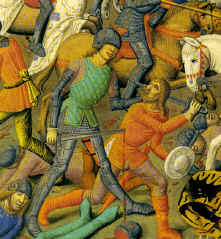 Although,
the sword and buckler is often associated with the fencing methods
of the early 1500s and with the common serving man, it was a
form of fighting with a much longer tradition. Sword and buckler
fighting also became a “combat sport” of sorts, but
not before it had already long been a martial system of self-defense
and battlefield skill. What is recognizable about the
buckler is that it was foremost a military tool used in war
by both soldiers and knights. That the tradition survived
longer than large shields and ended up occasionally facing off
against the rapier has engendered it (no small thanks to Shakespeare)
with something of an unjust legacy. Given its military
fitness, its eventual unsuitability for civilian duelling and
urban combat during the age of the rapier comes as no surprise. Although,
the sword and buckler is often associated with the fencing methods
of the early 1500s and with the common serving man, it was a
form of fighting with a much longer tradition. Sword and buckler
fighting also became a “combat sport” of sorts, but
not before it had already long been a martial system of self-defense
and battlefield skill. What is recognizable about the
buckler is that it was foremost a military tool used in war
by both soldiers and knights. That the tradition survived
longer than large shields and ended up occasionally facing off
against the rapier has engendered it (no small thanks to Shakespeare)
with something of an unjust legacy. Given its military
fitness, its eventual unsuitability for civilian duelling and
urban combat during the age of the rapier comes as no surprise.
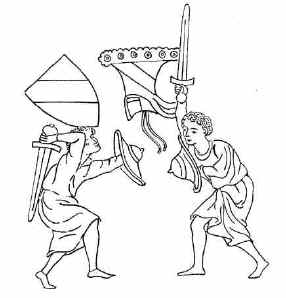 But
the study of the sword and buckler has suffered somewhat from
a lack of attention by historians of fencing and Medieval warfare.
On the one hand, it is so ubiquitous as to not be of much significance,
and on the other, because of comparisons to 16th
century rapier fencing, it is frequently viewed as being somehow
brutish or unsophisticated. Further, while assorted types
of shield developed and changed their shapes and sizes, bucklers
remained much more consistent, so scholars and historians have
not had much reason to focus on them. As well, unlike
shields bucklers served no heraldic function either and this
too has perhaps limited some of their appeal. But
the study of the sword and buckler has suffered somewhat from
a lack of attention by historians of fencing and Medieval warfare.
On the one hand, it is so ubiquitous as to not be of much significance,
and on the other, because of comparisons to 16th
century rapier fencing, it is frequently viewed as being somehow
brutish or unsophisticated. Further, while assorted types
of shield developed and changed their shapes and sizes, bucklers
remained much more consistent, so scholars and historians have
not had much reason to focus on them. As well, unlike
shields bucklers served no heraldic function either and this
too has perhaps limited some of their appeal.
La Petite Defense
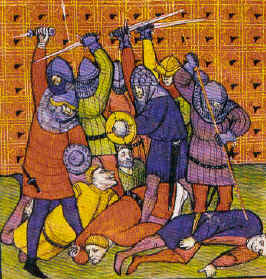 A
buckler differs from a shield in that the latter is carried
by straps and worn on the arm whereas the former is held in
single-hand in a “fist” grip. It is difficult
to trace the history of the weapon as many times any type of
round shield or small targe would be called buckler, regardless
of whether it was held in the fist or worn on the arm.[2] The buckler
was a small, maneuverable, hand-held shield for deflecting and
punching blows. It was usually round and made of metal but occasionally
of hardened leather or layers of wood. (Tarassuk & Blaire,
p. 105). Bucklers were typically round and frequently
between 8 to 16 inches in diameter, but octagonal, square, and
trapezoidal versions were also known. A
buckler differs from a shield in that the latter is carried
by straps and worn on the arm whereas the former is held in
single-hand in a “fist” grip. It is difficult
to trace the history of the weapon as many times any type of
round shield or small targe would be called buckler, regardless
of whether it was held in the fist or worn on the arm.[2] The buckler
was a small, maneuverable, hand-held shield for deflecting and
punching blows. It was usually round and made of metal but occasionally
of hardened leather or layers of wood. (Tarassuk & Blaire,
p. 105). Bucklers were typically round and frequently
between 8 to 16 inches in diameter, but octagonal, square, and
trapezoidal versions were also known.
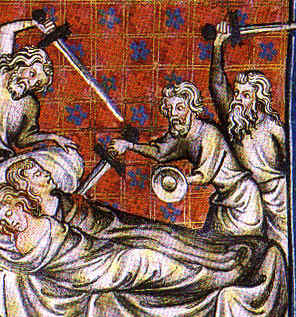 Considerable varieties
of bucklers were developed. Often a pointed spike protruded
from the central boss or umbo.[3]
Many bucklers were pointed with a central tip or several smaller
“teeth”. These points could be used offensively
to great effect as well as aided in binding and deflecting an
opponent’s weapon. John Stow wrote in 1631 how using
the buckler’s long “pyke” (a spikes 8- 12 inches
long) it was the habit of the old fighters “either to breake
the swords of their enemies, or suddenly to runne into them
and stab”. (Aylward, p. 17). An English Royal proclamation in 1562 even complained of “bucklers
with long pykes in them.” (Norman, p. 24) and a
spiked buckler from c. 1607 was even found at the Jamestown
settlement fort in Virginia. Some 16th century
bucklers also had raised metal rings, hooks, or bands that allowed
for the catching or knocking of opposing blades. Samples
of bucklers with these can be seen on display today in the Wallace
Collection Museum in London. Even the special concave
buckler, ostensibly developed in the 1500s to more easily facilitate
deflecting of rapier thrusts, seems to appear much earlier in
a French image of 1375. The light and shadow in the artwork
clearly show the buckler to be curved inward and given the variety
of short, tapering, thrusting swords in use at the time, this
is not difficult to accept. Considerable varieties
of bucklers were developed. Often a pointed spike protruded
from the central boss or umbo.[3]
Many bucklers were pointed with a central tip or several smaller
“teeth”. These points could be used offensively
to great effect as well as aided in binding and deflecting an
opponent’s weapon. John Stow wrote in 1631 how using
the buckler’s long “pyke” (a spikes 8- 12 inches
long) it was the habit of the old fighters “either to breake
the swords of their enemies, or suddenly to runne into them
and stab”. (Aylward, p. 17). An English Royal proclamation in 1562 even complained of “bucklers
with long pykes in them.” (Norman, p. 24) and a
spiked buckler from c. 1607 was even found at the Jamestown
settlement fort in Virginia. Some 16th century
bucklers also had raised metal rings, hooks, or bands that allowed
for the catching or knocking of opposing blades. Samples
of bucklers with these can be seen on display today in the Wallace
Collection Museum in London. Even the special concave
buckler, ostensibly developed in the 1500s to more easily facilitate
deflecting of rapier thrusts, seems to appear much earlier in
a French image of 1375. The light and shadow in the artwork
clearly show the buckler to be curved inward and given the variety
of short, tapering, thrusting swords in use at the time, this
is not difficult to accept.
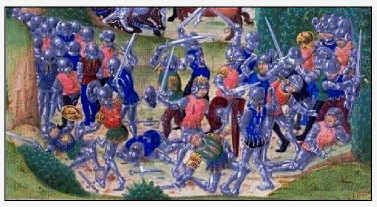 The
versatility of the sword and buckler as a method of fighting
can be said to lay in its simplicity. As a two-weapon combination,
it is simultaneously defensive and offensive. It offered
some protection against missile weapons and was convenient for
facing heavier weapons such as polearms and axes.[4]
Yet, its small size made it agile and quick. Combined
with a good shearing sword or tapering cut-and-thrust blade,
it could deflect attacks, strike blows of its own, and yet still
allow the user’s own sword to cut around in any direction.
Another advantage of metal bucklers was that unlike wooden
shields, the point of an opponent’s weapon would not get
stuck in the face of the buckler nor would the edge of a blade
damage the rim (although, when this occurred it could be used
to the shield man’s advantage). In many of the historical
images of sword and buckler combat the familiar fighting postures
found in longsword fencing manuals can be easily discerned,
such as the wards of: high, middle, low, back, and hanging. The
versatility of the sword and buckler as a method of fighting
can be said to lay in its simplicity. As a two-weapon combination,
it is simultaneously defensive and offensive. It offered
some protection against missile weapons and was convenient for
facing heavier weapons such as polearms and axes.[4]
Yet, its small size made it agile and quick. Combined
with a good shearing sword or tapering cut-and-thrust blade,
it could deflect attacks, strike blows of its own, and yet still
allow the user’s own sword to cut around in any direction.
Another advantage of metal bucklers was that unlike wooden
shields, the point of an opponent’s weapon would not get
stuck in the face of the buckler nor would the edge of a blade
damage the rim (although, when this occurred it could be used
to the shield man’s advantage). In many of the historical
images of sword and buckler combat the familiar fighting postures
found in longsword fencing manuals can be easily discerned,
such as the wards of: high, middle, low, back, and hanging.
A Lengthy Legacy
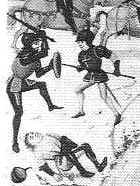 In the Middle Ages,
bucklers were common armaments among both knights and common
soldiers – even more so than shields. A buckler
was less cumbersome and more agile than a larger shield and
easier to carry about or wear on the hip. We know that
sword and buckler play was a popular pastime in northern Italy,
in Germany, and in England. As
British historical fencing researcher-practitioner Martin J.
Austwick has pointed out: “The earliest references to professional
combat instructors or masters of defense as they were to become
known all have one thing in common. They refer to schools
of sword and buckler. Add to this the fact that the earliest
known fechtbuch or fight book is dedicated solely to sword and
buckler combat, then it becomes apparent that sword and buckler
combat is arguably the oldest surviving martial tradition within
Western Martial Arts today.”[5] In the Middle Ages,
bucklers were common armaments among both knights and common
soldiers – even more so than shields. A buckler
was less cumbersome and more agile than a larger shield and
easier to carry about or wear on the hip. We know that
sword and buckler play was a popular pastime in northern Italy,
in Germany, and in England. As
British historical fencing researcher-practitioner Martin J.
Austwick has pointed out: “The earliest references to professional
combat instructors or masters of defense as they were to become
known all have one thing in common. They refer to schools
of sword and buckler. Add to this the fact that the earliest
known fechtbuch or fight book is dedicated solely to sword and
buckler combat, then it becomes apparent that sword and buckler
combat is arguably the oldest surviving martial tradition within
Western Martial Arts today.”[5]
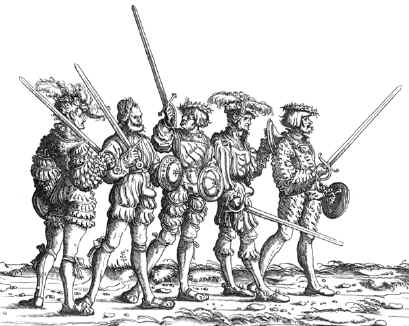 The
primary use of the buckler in Europe was by infantry. Light
infantry, made up of commoners armed with bucklers and swords
or falchions lined up behind troops with pole-weapons, were
used frequently in armies during the 1100s to 1300s. Early Medieval
pictorial sources, from c.650 to c.1100, additionally show bucklers
in use by Celtic, Frankish, and Byzantine horsemen. Medievalist
Donald Kagay reports of ordinances from 1363 by the Crown of
Aragon’s parliament of Monzón which specified the military
equipment required for frontier troops on active duty.
Light mounted troops were required to have among their weapons
a cuyrase (breast plate), a camisol (maile shirt),
helmet, lance, and a small round leather shield called a darga
de scut.[6]
Bucklers are also common in Medieval artwork depicting Middle
Eastern warriors, but these small shields are actually for mounted
combat and are typically held sideways by two straps as opposed
to the center-held buckler with its single handle. But
the sword and buckler was most effective in foot combat such
as with the Italian Rotulari (c. 1475) buckler infantry.
One historian best explains their development: “It was
to combat the new emphasis on field fortifications that a new
type of infantry became popular in Italian armies. This was
the so-called ‘sword and buckler’ infantry, first
experimented with by Braccio. They were lightly armed, agile,
and equipped for hand-to-hand offensive fighting. The type had
already been developed in Spain in fighting with the Moors,
and the establishment of Aragonese in Naples in the 1440s clearly
had something to do with their appearance in Italy at this time.”[7] The
primary use of the buckler in Europe was by infantry. Light
infantry, made up of commoners armed with bucklers and swords
or falchions lined up behind troops with pole-weapons, were
used frequently in armies during the 1100s to 1300s. Early Medieval
pictorial sources, from c.650 to c.1100, additionally show bucklers
in use by Celtic, Frankish, and Byzantine horsemen. Medievalist
Donald Kagay reports of ordinances from 1363 by the Crown of
Aragon’s parliament of Monzón which specified the military
equipment required for frontier troops on active duty.
Light mounted troops were required to have among their weapons
a cuyrase (breast plate), a camisol (maile shirt),
helmet, lance, and a small round leather shield called a darga
de scut.[6]
Bucklers are also common in Medieval artwork depicting Middle
Eastern warriors, but these small shields are actually for mounted
combat and are typically held sideways by two straps as opposed
to the center-held buckler with its single handle. But
the sword and buckler was most effective in foot combat such
as with the Italian Rotulari (c. 1475) buckler infantry.
One historian best explains their development: “It was
to combat the new emphasis on field fortifications that a new
type of infantry became popular in Italian armies. This was
the so-called ‘sword and buckler’ infantry, first
experimented with by Braccio. They were lightly armed, agile,
and equipped for hand-to-hand offensive fighting. The type had
already been developed in Spain in fighting with the Moors,
and the establishment of Aragonese in Naples in the 1440s clearly
had something to do with their appearance in Italy at this time.”[7]
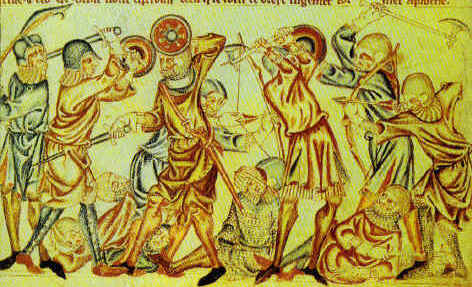
| There is no question of the buckler's popularity over
the centuries. The Holkham Picture Bible Book
from the early 1300s offers illustrations of combat
including that between mounted knights using sword and
lance, and between common soldiers (le commoune gent)
on foot using axe, falchion, spear, and short sword
with small round buckler. (Prestwich, p.
115). An image, dated to the 2nd half of the 14th century,
of sword and buckler facing longsword, can even be found
in the chapter on violent crimes from the State laws
of King Magnus Eriksson, Sweden. |
|
| |
|
|
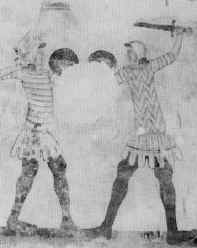
|
Fresco paintings from c.1340 of northern Italian infantry
fighting with sword and buckler can be found on the
castle of Sabbionara at Avio in Trento. A late 13th
century image from Tuscany also depicts maile-clad helmeted
infantry armed only with sword and buckler. A
French illumination from c.1317 of the Legende de St.
Denis shows militia meeting the king and equipped with
buckler among other weapons (MS Fr. 2090-2. f.129r.
Paris). A carved relief depicting two sleeping
Swabian guards from c.1350 shows them equipped with
sword and buckler and wearing maile and partial plate
armor. (Nicolle, Arms and Armor, p. 191).
An astrological text from the late 14th century offers
a colorful image depicting a range of martial exercises
practiced in the sun outdoors, including sword and buckler
fencing. (C. F. Black, p. 132) |
| Another manuscript illustration of a boar hunt dated
c.1300-1350 shows two hunters armed with sword and buckler
and sword and cloak. (Nicolle, Arms and Armor,
p. 191).[8] A c.1305 image
from Flanders of the battle Courtrai portrays numerous
maile-clad helmeted Flemish militiamen on foot with
bucklers, but no larger shields are shown. |
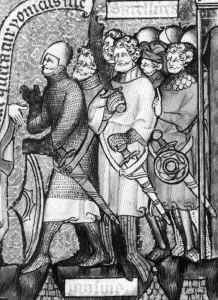
|
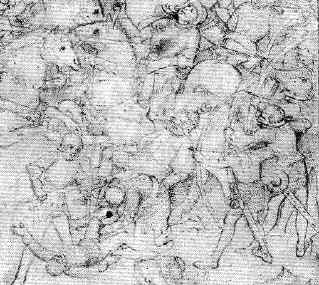 At
the Agincourt battle in 1415, the only defence recorded for
the English bowmen is a round buckler 1 foot in diameter.
(Edge, p. 65). The 1457, Bridport Muster Roll shows
that many of the common folk called up (including 5 apparent
women) were equipped with sword and buckler. While a description
by Dominic Mancini in 1483 of the equipment of the troops under
Richard Duke of Gloucester (the future Richard III) noted, “the
sword is accompanied by an iron buckler.” (Edge, p. 128).
The Spanish sword and buckler men of the early 1500s are
among the best known proponents of the weapons. They wreaked
havoc up and down the battlefields of Europe, even against the
famed Swiss pikemen. A favored tactic was to close against
pike formations and try to roll under the polearms then pop
up among their clustered opponents where their shorter weapons
could wreak havoc. At
the Agincourt battle in 1415, the only defence recorded for
the English bowmen is a round buckler 1 foot in diameter.
(Edge, p. 65). The 1457, Bridport Muster Roll shows
that many of the common folk called up (including 5 apparent
women) were equipped with sword and buckler. While a description
by Dominic Mancini in 1483 of the equipment of the troops under
Richard Duke of Gloucester (the future Richard III) noted, “the
sword is accompanied by an iron buckler.” (Edge, p. 128).
The Spanish sword and buckler men of the early 1500s are
among the best known proponents of the weapons. They wreaked
havoc up and down the battlefields of Europe, even against the
famed Swiss pikemen. A favored tactic was to close against
pike formations and try to roll under the polearms then pop
up among their clustered opponents where their shorter weapons
could wreak havoc.
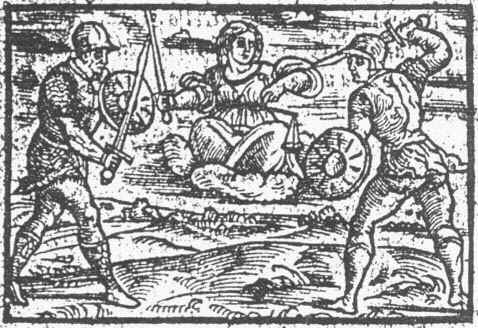 By 1500, the Spanish
infantry of Gonsalvo de Cordova used short thrusting swords
and bucklers, wore steel caps, breast and back plates, and greaves.
(Oman, p. 63). The infamous Machiavelli himself in his
own 1521 Arte of Warre, wrote of how at the battle of
Barletta in 1503 the Spanish sword and buckler men dealt with
the Swiss pikemen: “When they came to engage, the Swiss
pressed so hard on their enemy with their pikes, that they soon
opened their ranks; but the Spaniards, under the cover of their
bucklers, nimbly rushed in upon them with their swords, and
laid about them so furiously, that they made a very great slaughter
of the Swiss, and gained a complete victory.” (Machiavelli,
p. 66). As Machiavelli tells it, the Spaniards at the battle
of Ravenna in 1512 fell furiously on the Germans, “rushing
at the pikes, or throwing themselves on the ground and slipping
below the points, so that they darted in among the legs of the
pikemen.” The Spaniards “made so good a use
of their swords, that not one of the enemy would have been left
alive, if a body of French cavalry had not fortunately come
up to rescue them.” (Machiavelli, p. 70). “This
fight was typical of many more in which during the first quarter
of the sixteenth century the sword and buckler were proved to
be more than master of the pike.” (Oman, p. 110). In
1618 Adam van Breen wrote a work in the Netherlands on military
drill which in 1625 was reprinted as Mars His Field,
“or The Exercise of Armes, wherein in lively figures is
shewn the Right use and perfect manner of Handling the Buckler,
Sword, and Pike...” By 1500, the Spanish
infantry of Gonsalvo de Cordova used short thrusting swords
and bucklers, wore steel caps, breast and back plates, and greaves.
(Oman, p. 63). The infamous Machiavelli himself in his
own 1521 Arte of Warre, wrote of how at the battle of
Barletta in 1503 the Spanish sword and buckler men dealt with
the Swiss pikemen: “When they came to engage, the Swiss
pressed so hard on their enemy with their pikes, that they soon
opened their ranks; but the Spaniards, under the cover of their
bucklers, nimbly rushed in upon them with their swords, and
laid about them so furiously, that they made a very great slaughter
of the Swiss, and gained a complete victory.” (Machiavelli,
p. 66). As Machiavelli tells it, the Spaniards at the battle
of Ravenna in 1512 fell furiously on the Germans, “rushing
at the pikes, or throwing themselves on the ground and slipping
below the points, so that they darted in among the legs of the
pikemen.” The Spaniards “made so good a use
of their swords, that not one of the enemy would have been left
alive, if a body of French cavalry had not fortunately come
up to rescue them.” (Machiavelli, p. 70). “This
fight was typical of many more in which during the first quarter
of the sixteenth century the sword and buckler were proved to
be more than master of the pike.” (Oman, p. 110). In
1618 Adam van Breen wrote a work in the Netherlands on military
drill which in 1625 was reprinted as Mars His Field,
“or The Exercise of Armes, wherein in lively figures is
shewn the Right use and perfect manner of Handling the Buckler,
Sword, and Pike...”
 Author
Wilbur Prescott writing on the art of war in late Medieval
Spain, suggests the reason for the proficiency of the Spanish
sword and buckler men of the early 1500s, was curiously,
their considerable experience in late 15th century
siege warfare which at the time relied heavily on close
combat skills with shields. (Prescott, p. 26). Following
along the work of Vegetius (influential throughout the Middle
Ages and Renaissance), Machiavelli even suggested that armies
of the time should actually equip their soldiers with swords
and bucklers. Their advantage in pike warfare lay
in the well-timed ability of such agile fighters to close
in among the longer weapons of their tightly packed adversaries. In
1583 the Italian military writer Cesare d’Evoli said
he favored small round metal shields for deflecting pikes.
(Anglo, p. 220). Author
Wilbur Prescott writing on the art of war in late Medieval
Spain, suggests the reason for the proficiency of the Spanish
sword and buckler men of the early 1500s, was curiously,
their considerable experience in late 15th century
siege warfare which at the time relied heavily on close
combat skills with shields. (Prescott, p. 26). Following
along the work of Vegetius (influential throughout the Middle
Ages and Renaissance), Machiavelli even suggested that armies
of the time should actually equip their soldiers with swords
and bucklers. Their advantage in pike warfare lay
in the well-timed ability of such agile fighters to close
in among the longer weapons of their tightly packed adversaries. In
1583 the Italian military writer Cesare d’Evoli said
he favored small round metal shields for deflecting pikes.
(Anglo, p. 220). |
GO
TO NEXT SECTION
Footnotes for Part
1
[1]
The word is derived from the Old French bocle
for the “buckle-like” boss or umbo on a shield.
The term “boss” is from the 12th century
French Boce, bocle, called bloca, in
12th-13th century Spain (Nicolle,
Arms and Armor, p. 549).
[2]
The 1611 edition of Florio’s Italian-English
dictionary, gives Brocchiéro, Broccoliéro, as “a
buckler, a target, a shield.” Although often
described as near synonymous with the buckler, a targe (or
targa and adarga) differed from a buckler
in that it was a small wooden shield with a leather cover
and leather or metal trim. Some were also covered
with metal studs or spikes. Unlike bucklers, targes
were worn on the arm like other types of shields.
They were also usually flat rather than convex. Elizabethans
referred to the practice of “Sworde
and targat”. The word “targe” apparently
comes from small “targets” placed on archery practice
dummies. Some forms of medium sized steel shields
from the Renaissance are often classed as targes or the
Italian rondella . Though associated with the Scots, the
“targe” was actually used throughout Europe. They
were most popular in the early Renaissance and the Scots
were merely the last to use them.
[3]
Following Livy, T. Thomas’s 1587 Latin-English
dictionary, Dictionarium Linguae Latinae et Anglicanae,
defined umbo as “the bosse of a buckler or shield (London,
R. Boyle). Thomas also listed Parmularius as
“A buckler or target maker, or he that useth such a
one” and the old Roman Pelta as “A target
or buckler like a halfe moone: also a square buckler or
targen.”
[4]
It has also been speculated that an advantage
of the buckler in the crush of Medieval combat lay in its
adaptability. Whereas a larger shield worn on the
arm could be hooked or pulled by various types of polearms
and axes, thereby vulnerably encumbering the fighter, a
smaller more nimble hand-held buckler could easily dislodge
itself from such attempts or suddenly be discarded by a
fighter.
[7]
Michael Mallet.
Mercenaries and Their Masters – Warfare in Renaissance
Italy. Rowman and Littlefield, Totowa, NJ, 1974, p.
155.
- [9] De Wapen-handelinge
van schilt, spies, rapiers, en targis. Nae de nieuwe ordere,
vanden...prince van Oraignien, Mauritius van Nassauw ...
Door Adam van Breen in figuren ... The Hague, Ghedruckt ...door H. Hondius, 1640.
|

